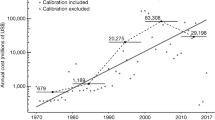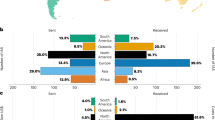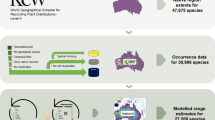Abstract
Biological invasions threaten global biodiversity, human well-being and economies. Many regional and taxonomic syntheses of monetary costs have been produced recently but with important knowledge gaps owing to uneven geographic and taxonomic research intensity. Here we combine species distribution models, macroeconomic data and the InvaCost database to produce the highest resolution spatio-temporal cost estimates currently available to bridge these gaps. From a subset of 162 invasive species with ‘highly reliable’ documented costs at the national level, our interpolation focuses on countries that have not reported any costs despite the known presence of invasive species. This analysis demonstrates a substantial underestimation, with global costs potentially estimated to be 1,646% higher for these species than previously recorded. This discrepancy was uneven geographically and taxonomically, respectively peaking in Europe and for plants. Our results showed that damage costs were primarily driven by gross domestic product, human population size, agricultural area and environmental suitability, whereas management expenditure correlated with gross domestic product and agriculture areas. We also found a lag time for damage costs of 46 years, but management spending was not delayed. The methodological predictive approach of this study provides a more complete view of the economic dimensions of biological invasions and narrows the global disparity in invasion cost reporting.
This is a preview of subscription content, access via your institution
Access options
Access Nature and 54 other Nature Portfolio journals
Get Nature+, our best-value online-access subscription
$32.99 / 30 days
cancel any time
Subscribe to this journal
Receive 12 digital issues and online access to articles
$119.00 per year
only $9.92 per issue
Buy this article
- Purchase on SpringerLink
- Instant access to full article PDF
Prices may be subject to local taxes which are calculated during checkout




Similar content being viewed by others
Data availability
All data generated and analysed during this study are publicly available and can be accessed via GitHub at https://github.com/IsmaSA/Invacost_SDM. Source data are provided with this paper.
Code availability
All codes generated during this study are available and can be accessed via GitHub at https://github.com/IsmaSA/Invacost_SDM.
References
Pyšek, P. et al. Scientists’ warning on invasive alien species. Biol. Rev. 95, 1511–1534 (2020).
Blackburn, T. M., Bellard, C. & Ricciardi, A. Alien versus native species as drivers of recent extinctions. Front. Ecol. Environ. 17, 203–207 (2019).
Roy, H. E., Pauchard, A., Stoett, P. & Renard Truong, T. Thematic Assessment Report on Invasive Alien Species and their Control of the Intergovernmental Science-Policy Platform on Biodiversity and Ecosystem Services (IPBES). Zenodo https://doi.org/10.5281/zenodo.7430682 (2023).
Turbelin, A. J. et al. Biological invasions are as costly as natural hazards. Perspect. Ecol. Conserv. 21, 143–150 (2023).
Diagne, C. et al. High and rising economic costs of biological invasions worldwide. Nature 592, 571–576 (2021).
Ahmed, D. A. et al. Recent advances in availability and synthesis of the economic costs of biological invasions. Bioscience 73, 560–574 (2023).
Seebens, H. et al. No saturation in the accumulation of alien species worldwide. Nat. Commun. 8, 14435 (2017).
Haubrock, P. J. et al. Geographic and taxonomic trends of rising biological invasion costs. Sci. Total Environ. 817, 152948 (2022).
Diagne, C. et al. InvaCost, a public database of the economic costs of biological invasions worldwide. Sci. Data 7, 277 (2020).
Crystal-Ornelas, R. et al. Economic costs of biological invasions within North America. NeoBiota 67, 485–510 (2021).
Cuthbert, R. N. et al. Global economic costs of aquatic invasive alien species. Sci. Total Environ. 775, 145238 (2021).
Angulo, E. et al. Non-English languages enrich scientific knowledge: the example of economic costs of biological invasions. Sci. Total Environ. 775, 144441 (2021).
Nuñez, M. A., Chiuffo, M. C., Pauchard, A. & Zenni, R. D. Making ecology really global. Trends Ecol. Evol. 36, 766–769 (2021).
Elith, J. In Invasive Species: Risk Assessment and Management (eds. Robinson, A. P. et al.) (Cambridge Univ. Press, 2017).
Della Venezia, L., Samson, J. & Leung, B. The rich get richer: invasion risk across North America from the aquarium pathway under climate change. Divers. Distrib. 24, 285–296 (2018).
Parker, I. M. et al. Impact: toward a framework for understanding the ecological effects of invaders. Biol. Invasions 1, 3–19 (1999).
Essl, F. et al. Potential sources of time lags in calibrating species distribution models. J. Biogeogr. 51, 89–102 (2023).
Henry, M. et al. Unveiling the hidden economic toll of biological invasions in the European Union. Environ. Sci. Eur. 35, 1–16 (2023).
Courtois, P., Figuieres, C., Mulier, C. & Weill, J. A cost–benefit approach for prioritizing invasive species. Ecol. Econ. 146, 607–620 (2018).
Newman, R. & Noy, I. The global costs of extreme weather that are attributable to climate change. Nat. Commun. 14, 6103 (2023).
Briski, E., Drake, D. A. R., Chan, F. T., Bailey, S. A. & MacIsaac, H. J. Variation in propagule and colonization pressures following rapid human‐mediated transport: implications for a universal assemblage‐based management model. Limnol. Oceanogr. 59, 2068–2076 (2014).
Turbelin, A. J. et al. Biological invasions as burdens to primary economic sectors. Glob. Environ. Change 87, 102858 (2024).
Boscutti, F., Sigura, M., De Simone, S. & Marini, L. Exotic plant invasion in agricultural landscapes: a matter of dispersal mode and disturbance intensity. Appl. Veg. Sci. 21, 250–257 (2018).
Soto, I. et al. The wild cost of invasive feral animals worldwide. Sci. Total Environ. 912, 169281 (2024).
Wang, S., Deng, T., Zhang, J. & Li, Y. Global economic costs of mammal invasions. Sci. Total Environ. 857, 159479 (2023).
Essl, F. et al. Socioeconomic legacy yields an invasion debt. Proc. Natl Acad. Sci. USA 108, 203–207 (2011).
Ahmed, D. A. et al. Managing biological invasions: the cost of inaction. Biol. Invasions 24, 1927–1946 (2022).
Haubrock, P. J., Cuthbert, R. N., Ricciardi, A., Diagne, C. & Courchamp, F. Economic costs of invasive bivalves in freshwater ecosystems. Diversity Distrib. 28, 1010–1021 (2022).
Lenoir, J. et al. Species better track climate warming in the oceans than on land. Nat. Ecol. Evol. 4, 1044–1059 (2020).
Hughes, A. C. et al. Sampling biases shape our view of the natural world. Ecography 44, 1259–1269 (2021).
Bradshaw, C. J. et al. Damage costs from invasive species exceed management expenditure in nations experiencing lower economic activity. Ecol. Econ. 220, 108166 (2024).
Hudgins, E. J. et al. Unevenly distributed biological invasion costs among origin and recipient regions. Nat. Sustain. 6, 1113–1124 (2023).
Novoa, A. et al. Global costs of plant invasions must not be underestimated. NeoBiota 69, 75–78 (2021).
Zhang, C. & Boyle, K. J. The effect of an aquatic invasive species (Eurasian watermilfoil) on lakefront property values. Ecol. Econ. 70, 394–404 (2010).
Lazzaro, L. et al. Invasive alien plant impacts on human health and well-being. in Invasive Species and Human Health (eds. Mazza, G. & Tricario, E.) pp. 16–33 (CAB International, 2018).
Cuthbert, R. et al. Economic impact disharmony in global biological invasions. Sci. Total Environ. 913, 169622 (2024).
Heringer, G. et al. Economic costs of invasive non-native species in urban areas: an underexplored financial drain. Sci. Total Environ. 917, 170336 (2024).
Soto, I. et al. Global economic costs of herpetofauna invasions. Sci. Rep. 12, 10829 (2022).
Parkes, J. P. & Panetta, F. D. Eradication of invasive species: progress and emerging issues in the 21st century. in Invasive Species Management. A Handbook of Principles and Techniques. 47–60 (Oxford Univ. Press, 2009).
Nguyen, D. & Leung, B. How well do species distribution models predict occurrences in exotic ranges? Glob. Ecol. Biogeogr. 31, 1051–1065 (2022).
Kourantidou, M. et al. The economic costs, management and regulation of biological invasions in the Nordic countries. J. Environ. Manag. 324, 116374 (2022).
Leroy, B. et al. Analysing economic costs of invasive alien species with the invacost R package. Methods Ecol. Evol. 13, 1930–1937 (2022).
Global Biodiversity Information Facility (GBIF, 2023); https://www.gbif.org
Phillips, S. J. et al. Sample selection bias and presence‐only distribution models: implications for background and pseudo‐absence data. Ecol. Appl. 19, 181–197 (2009).
Barbet‐Massin, M., Jiguet, F., Albert, C. H. & Thuiller, W. Selecting pseudo‐absences for species distribution models: how, where and how many? Methods Ecol. Evolution 3, 327–338 (2012).
Fick, S. E. & Hijmans, R. J. WorldClim 2: new 1‐km spatial resolution climate surfaces for global land areas. Int. J. Climatol. 37, 4302–4315 (2017).
Amatulli, G. et al. A suite of global, cross-scale topographic variables for environmental and biodiversity modeling. Sci. Data 5, 1–15 (2018).
Karger, D. N., Wilson, A. M., Mahony, C., Zimmermann, N. E. & Jetz, W. Global daily 1 km land surface precipitation based on cloud cover-informed downscaling. Sci. Data 8, 307 (2021).
CIESIN. Global Roads Open Access Data Set, Version 1 (gROADSv1) (NASA Socioeconomic Data and Applications Center, 2013); https://doi.org/10.7927/H4VD6WCT
Mainali, K. P. et al. Projecting future expansion of invasive species: comparing and improving methodologies for species distribution modeling. Glob. Change Biol. 21, 4464–4480 (2015).
Naimi, B., Skidmore, A. K., Groen, T. A. & Hamm, N. A. S. On uncertainty in species distribution modelling. ITC dissertation, Univ. Twente (2015).
Wood, S. mgcv: Mixed GAM computation vehicle with GCV/AIC/REML smoothness estimation and GAMMs by REML/PQL (Chapman and Hall/CRC, 2017).
Phillips, S. J., Anderson, R. P., Dudík, M., Schapire, R. E. & Blair, M. E. Opening the black box: an open‐source release of Maxent. Ecography 40, 887–893 (2017).
Araújo, M. B. et al. Standards for distribution models in biodiversity assessments. Sci. Adv. 5, eaat4858 (2019).
Merow, C. et al. What do we gain from simplicity versus complexity in species distribution models? Ecography 37, 1267–1281 (2014).
Briski, E. et al. Does non-native diversity mirror earth’s biodiversity. Glob. Ecol. Biodivers. 33, 48–62 (2024).
World Development Indicators (World Bank, 2023); www.data.worldbank.org
R Core Team. R: A language and environment for statistical computing (R Foundation for Statistical Computing, 2023); https://www.R-project.org/
Acknowledgements
We thank C. J. A. Bradshaw for his comments on an earlier version of this manuscript. R.L.M. was supported by the Alexander von Humboldt Foundation. R.N.C. is funded by the Leverhulme Trust.
Author information
Authors and Affiliations
Contributions
I.S. and B. Leung conceived the study, led on coding the analyses and data interpretation, designed and assembled the figures, designed the methodology, wrote the original draft and revised subsequent drafts. The following authors participated in the data acquisition or provided and approved the final draft: P.C., A.P., E.T., E.M., E.A., C.B., E.B., M.B., R.N.C., A.K., M.K., R.L.M., B. Leroy, P.J.H. and F.C.
Corresponding authors
Ethics declarations
Competing interests
The authors declare no competing interests.
Peer review
Peer review information
Nature Ecology & Evolution thanks Daniel Silva and the other, anonymous, reviewer(s) for their contribution to the peer review of this work.
Additional information
Publisher’s note Springer Nature remains neutral with regard to jurisdictional claims in published maps and institutional affiliations.
Supplementary information
Supplementary Information
Supplementary Figs. 1 and 2, Tables 1–8 and Materials 1–3.
Source data
Source Data Fig. 2
Statistical source data.
Source Data Fig. 3
Statistical source data.
Source Data Fig. 4
Statistical source data.
Rights and permissions
Springer Nature or its licensor (e.g. a society or other partner) holds exclusive rights to this article under a publishing agreement with the author(s) or other rightsholder(s); author self-archiving of the accepted manuscript version of this article is solely governed by the terms of such publishing agreement and applicable law.
About this article
Cite this article
Soto, I., Courtois, P., Pili, A. et al. Using species ranges and macroeconomic data to fill the gap in costs of biological invasions. Nat Ecol Evol 9, 1021–1030 (2025). https://doi.org/10.1038/s41559-025-02697-5
Received:
Accepted:
Published:
Issue date:
DOI: https://doi.org/10.1038/s41559-025-02697-5
This article is cited by
-
Predicting invasion costs from sparse data
Nature Ecology & Evolution (2025)



